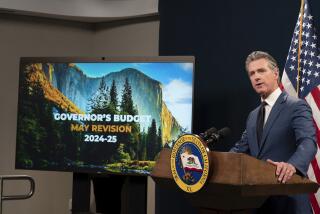Television Politics: an Advertising Flood, an Information Drought
We’ve been here before, haven’t we? Two days away from another election, we feel insulted, soiled, numb, patronized.
Lobotomized.
We can’t imagine how such insipid candidates for California governor are spawned, and I don’t know about you, but I’d rather have car doors slammed on my fingers than be forced to watch another loathsome TV ad.
Those who do vote -- the shrinking minority who haven’t had all sense of civic duty beaten out of us -- will probably cast a ballot for the lesser of evils.
So how does this keep happening, not just in the California governor’s race but throughout American politics? How come the country that can’t stop pitching democracy to the rest of the world is unable to conduct an election that enlightens and engages the public?
Lots of reasons, and I could talk about the need for public financing of campaigns or caps on fund-raising. But today I’ll focus on something else.
I’m sitting at home in front of the television, sacrificing the few remaining brain cells to regular programming, and what do I see virtually every time there’s a commercial break?
Another political ad.
As of Oct. 15 in Los Angeles, 14,294 TV ads had been aired in the campaign 2002 season. In the San Francisco-Oakland market, there were 13,400 ads, according to the Alliance for Better Campaigns.
These ads are not cheap. If they were, Gov. Gray Davis might not have spent his entire term hitting up every breathing resident for cash, raising allegations the man can be bought.
Do you have any idea how much money California’s TV stations had raked in from political ads as of Oct. 15? The answer is a staggering $72,189,287, and that was before the crushing assault of last-minute ads over the last two weeks.
“That’s what politics is in California,” says Paul Taylor of Better Campaigns. “No one does anything but beg for dollars to pay for TV ads.”
We’re not alone. Nationally, TV stations will pocket $1 billion for this campaign season, says Taylor. It wouldn’t be so bad if you could learn something from these 30-second spots. But they’re a plague.
We’d have had a better run for governor if Dick Riordan had survived the primary. But Gov. Davis blew him out of the water with TV ads before anyone knew whether Riordan could swim.
TV ads are simplifications at best, gross distortions at worst, and perhaps as responsible as any factor in feeding voter cynicism. So what might TV stations do in return for profiting like robber barons while performing such a public disservice?
They might now and then drop one car chase, one celebrity puff ball, one vapid exchange between look-alike anchors, and use the time to help clarify a campaign issue. But if a candidate is not in a stolen car, a fire, or the daily homicide, the chance for air time is slim.
“Back in 1994, the O.J. trial was taking place at the height of the campaign season, so we would schedule major media events in the parking lot across from the courthouse,” says Dan Schnur, who did PR for former Gov. Pete Wilson.
TV stations in the nation’s 50 largest markets air four times as many political ads as campaign stories, according to a report last week co-sponsored by the Norman Lear Center at USC. Of the 4,850 stations in the study, 63% had no campaign coverage, and less than 5% had any stories challenging the distortions in the paid ads.
“The common point of view is that covering politics is ratings poison,” says Marty Kaplan of USC. “But it certainly doesn’t seem to affect their decisions about airing ads.”
The ratings argument by TV news people is a sham. It’s not like the stuff they do broadcast has us on the edge of our seats. And a 12-year-old could come up with creative ways to cover political issues that affect the lives of every viewer.
KTVU in Oakland does more and better political coverage than any other commercial news station in California. Political reporter Randy Shandobil says there’s no indication that ratings tank when his station devotes five- and six-minute stories to the governor’s race, as it did for an entire week during the World Series.
KTLA anchor Hal Fishman says his station hits the political highlights. But TV news is a headline service that offers up “a seven-course meal” each night.
“We don’t go into tremendous depth,” Fishman admitted. “We’re not the L.A. Times.”
Nobody in their right mind is expecting tremendous depth. We’re just looking for that seven-course meal to occasionally have a few nutrients.
Norman Lear had it right when he once told me that TV isn’t an information or entertainment venture; it’s a marketing medium.
But given the fact the public owns the airwaves, and TV stations operate at the discretion of the government, they’ve got a moral responsibility to give something back.
And if they don’t comply out of a sense of duty, there might soon be a gun to their heads.
A bill introduced two weeks ago by Sens. John McCain (R-Ariz.) and Richard Durbin (D-Ill.) would require TV and radio stations to air at least two hours a week of candidate- or issue-centered programming in the homestretch of campaigns for national office.
The bill would also help lesser-known candidates compete with the fat cats by offering TV air-time vouchers to those who can gather enough small-potatoes campaign contributions. It’s one more way of helping to break the rule of big money in politics.
I don’t see why we can’t take some of these ideas and apply them to state campaigns.
“It’s no wonder people don’t want to vote,” says Schnur, the Republican strategist. “How many Californians can relate to either the zillionaire or the fund-raising android?”
We don’t have to wait until election day to know the answer to that one.
*
Steve Lopez writes Sunday, Wednesday and Friday. Reach him at steve.lopez@latimes.com
More to Read
Get the L.A. Times Politics newsletter
Deeply reported insights into legislation, politics and policy from Sacramento, Washington and beyond. In your inbox three times per week.
You may occasionally receive promotional content from the Los Angeles Times.







